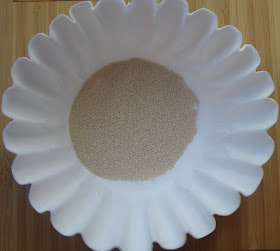One billion years ago, before man walked the Earth, appeared a separate kingdom, distinct from plants and animals kingdoms, named The FUNGI Kingdom. ... no is not a Martial Art style or the like.
In this kingdom was living many species of fungi (fungus), wild microorganisms that has been used since then as:
- a direct source of food: mushrooms, truffles
- a leavening agent for bread
- in fermentation of wine, beer, soy sauce, sake
- agent in the production of antibiotics
- enzyme source for various industries and for detergents
- biological agent to control weeds and pests.
- agent in producing ethanol in bio-fuel industry
Some species of fungi are toxic to animals and humans, but some of these living strains were selected according to their capacity to ferment food without producing harmful mycotoxin and were "domesticated". One of the earliest domesticated organisms used by Old Egyptians in their 4,000 year-old bakeries and breweries, is probably the Yeast, which was passed on from generation to generation.
In 1857 Louis Pasteur discovered and explained how yeast works: "Yeast feeds on the starches in flour, producing carbon dioxide; the carbon dioxide expands the gluten proteins in the flour and the gluten proteins cause the dough to expand and rise". He discovered also the pasteurization process, after demonstrated that fermentation and spoiled beverages are caused by growth microorganisms.
In 1857 Louis Pasteur discovered and explained how yeast works: "Yeast feeds on the starches in flour, producing carbon dioxide; the carbon dioxide expands the gluten proteins in the flour and the gluten proteins cause the dough to expand and rise". He discovered also the pasteurization process, after demonstrated that fermentation and spoiled beverages are caused by growth microorganisms.
The yeast is a living fungi with many useful physiological properties used in biotechnology, industrial ethanol production, nutritional supplements and probiotics products. The yeast is also used in decomposition of organic matter and in beer brewing and wine-making process.
Types of processed yeast products used as food additives:
 1. non-leavening yeast used to produce alcoholic
1. non-leavening yeast used to produce alcoholic  beverages or food supplements that provides proteins and vitamins to diets.
beverages or food supplements that provides proteins and vitamins to diets. The most common are:
- brewer yeast,
- wine yeast,
- sake yeast.
2. leavening yeasts (baker`s yeast) most used for baking bread or all kind of cookery. The most common are:
- Active Dry Yeast
or regular yeast, is the oldest and most commonly available form for home bakers with larger particle size than Instant Active Dry Yeast. The yeast is dormant, and is best used after proofing and re-hydrating with warm water and a little sugar.
- Instant Active Dry Yeast is a dry yeast genetically engineered in the past thirty years specially to produce breads. It comes in smaller granules than active dry yeast, does not require warm lichid to be activated before being mixed into flour and is a good choice for use with Bread Making Machines.
- Rapid Yeast or Quick Instant Yeast is a type of instant yeast that is low in moisture content and high in carbon dioxide content, less flavorful, that provides a quicker rise bread than instant active dry yeast does.
- Fresh Yeast also known as cake yeast, is active semi-moist yeast, rarely used by home bakers now, with good rising qualities for bread, croissants and pastries. The yeast should be pale gray-brown, fragrant, soft and crumbly and it will last about two weeks if refrigerated.



Excellent post with a lot of good information. Very useful, thanks!
ReplyDeleteray ban sunglasses outlet
ReplyDeletediscount oakley sunglasses
oakley sunglasses wholesale
cheap uggs
canada goose jackets
ray bans
polo ralph lauren outlet
polo ralph lauren
cheap ray ban sunglasses
oakley sunglasses cheap
zhi20161226